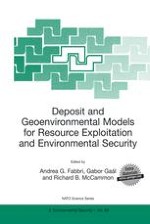2002 | OriginalPaper | Chapter
Asset Life-Cycle in the Mining Industry
How to improve economic and environmental decision-making by applying ICT
Author : I. L. Ritsema
Published in: Deposit and Geoenvironmental Models for Resource Exploitation and Environmental Security
Publisher: Springer Netherlands
Included in: Professional Book Archive
Activate our intelligent search to find suitable subject content or patents.
Select sections of text to find matching patents with Artificial Intelligence. powered by
Select sections of text to find additional relevant content using AI-assisted search. powered by
Understanding the interactions between earth systems and social economic systems is of crucial importance to assess, manage and steer towards sustainable environmental and social economic systems. This is especially true for social economic activities exploiting the earth systems as a natural resource, such as mining of natural resources.In assessing the consequences of each social economic activity, such as mining minerals or coal, the full life cycle should be considered in terms of both environmental and social economic impacts. The typical asset life cycle should include exploration, appraisal, development, production and last but not least abandonment. Typically the asset life-cycles of minerals or coal mines are finite lasting up to tens of years (being both storage resources), while the asset life-cycle of groundwater production could be infinite and in equilibrium, while its is recharged (being a sustainable resource). Impacts of all relevant mining scenarios should be assessed and should be compared to the desired state of the earth and social economic systems in each phase of the life cycle, optimizing decision-making. In early phases of the life cycle, impacts can only roughly be estimated and decision parameters will contain large uncertainties (including opportunities and risks), while in later phases more accurate estimates can be made and decisions will be more straightforward.Most mining companies are very good in assessing economic and social impact indicators, but to a lesser extent the environmental impact indicators. Economic impact is normally expressed in yearly cash flows and results in indicators such as net present values (NPV), return on investment (ROI), etc. Social impact includes employment and health indicators, etc. Earth systems impact is assessed for each of the following four interactions between these and socioeconomic systems: • geo-resources, where earth material reserves are extracted (such as minerals, coal, water,);• geo-space, where materials are stored in the subsurface (such as waste, pipelines, buildings),;• geo-risks, which are a risks to social economic activities (such as land subsidence, floods);• geo-environment, where the earth systems are disturbed (such as soil and water pollution).Each type of interactions has to be assessed and expressed in relevant indicator values, the first two expressed as potential benefits or values and the last two as potential risks or losses. The main economic and environmental aspects of asset life cycle management are discussed, illustrated with examples from similar industries.The conclusions are that there is a need for a systematic and integrated approach in assessing environmental and social economic impacts throughout the asset life cycle of mining operations. It is very important for companies to co-operate with all stakeholders, such as governmental ministries and surveys, regional and local authorities. Therefore a fast, clear and sound communication is essential.In this paper examples will be given how Information and Communication Technology (ICT) products can greatly facilitate these new business requirements. Examples of the use of telecommunication, data management, applications and decision support systems using WWW technology are shown.
